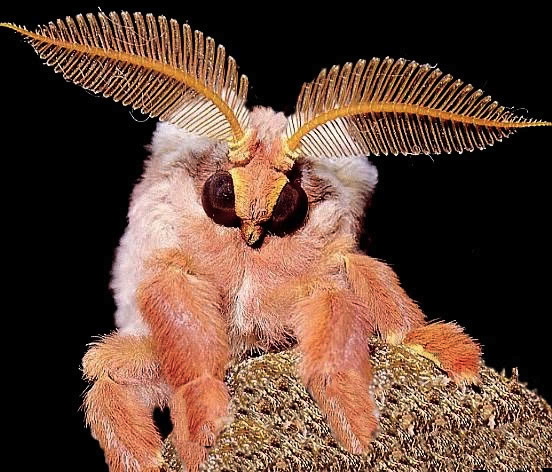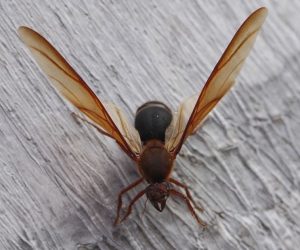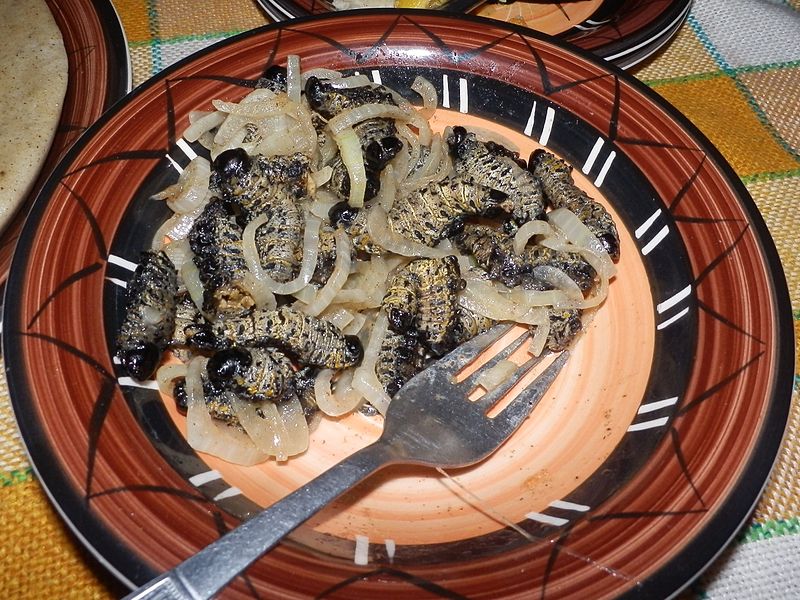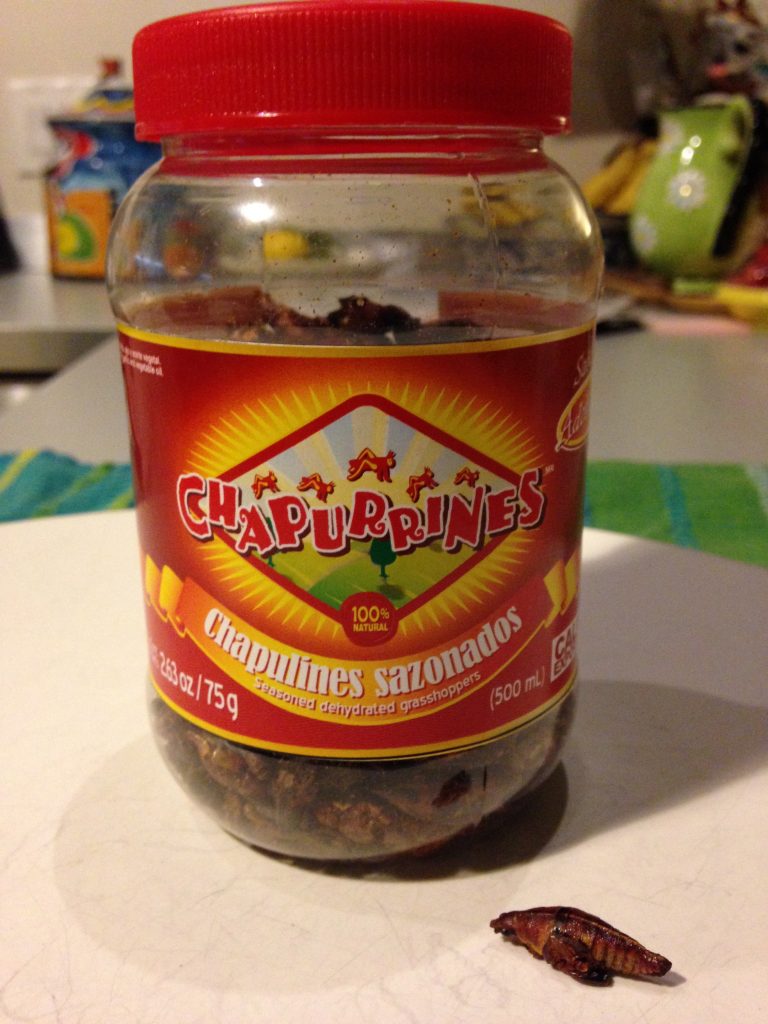One of my favorite radio programs, the Splendid Table, aired an interesting segment on Eating Bugs recently.
The show introduced the Mopane worm–technically a caterpillar–and how in just about every corner of the earth, people consume insects as food. The practice is called entomophagy. The Mopane “worm,” so named because he hosts on the Mopane tree, morphs into the magnificent Emerald Moth, Gonimbrasia belina.

Would you eat this guy? The caterpillar stage of the Emperor moth is a delicacy in parts of Africa and high in protein, too. Photo by Mark Goldstein, the Photography Blog
Stefan Gates, the “British gastronaut” interviewed on the public radio cooking show, spent 10 days eating insects in Cambodia and Thailand as research for the documentary. Gates readily admits that he accepted the assignment to consume crickets, grasshoppers and giant water bugs because it makes great TV. “That’s the shallow side of me,” he said. But Gates and program host Lynn Rosetto Caspar also explored why many of us are simply disgusted by the idea of eating bugs.
Insects are perfectly edible and yet we have such negative reactions to the idea. “Why are we disgusted and what lies beneath it?” he wondered aloud, noting that insects are everywhere, readily available, prolifically fertile and high in protein.
Other countries are not nearly as squeamish as the United States.
In Mexico, eating chapulines, a grasshopper of the Sphenarium species, is common practice. (They’re also the namesake of the famous Chapultepec Park in Mexico City. “Grasshopper Hill.”)
I grabbed two jars of the crispy, fried grasshopper carcasses seasoned with lime, chili and salt at the airport upon my return from a butterfly adventure in Huatulco, Oaxaca. The crispy bugs are not half bad with a beer.

Plump, juicy, available in the rainy season. Rip the wings off chicatanas and make a delicious molé. Photo by Veronica Prida
And check out the nutritional data–a third of an ounce has 39 calories and five grams of protein. Half a cup of chapulines added to a soup recently escaped notice–except for the knowledge that my broth was more healthy.
On the same trip, our guide Cornelio Ramos Gabriel, tried to track down for me the seasonal delicacy chicatanas in Oaxaca. The huge flying ants hatch after the first downpour of the rainy season. Locals scramble to collect them, remove their wings, roast them on a griddle, then grind them up to make a delicious molé that’s considered a delicacy. Alas, we had missed the season.
According to the United Nations, edible insects could be the answer to ensuring our future food security. In the 185-page report Edible insects: future prospects for food and feed security, the Food and Agriculture Organization of the United Nations notes that nine billion people will inhabit our planet by 2050 and require us to produce twice as much food as we do today. At least two billion people already tap more than 1,900 species of insects as part of their traditional diets.
The report, published last year, cited the most commonly eaten insects:
-
- Beetles Coleoptera 31 percent
- Caterpillars Lepidoptera 18 percent
- Bees, wasps and ants, Hymenoptera 14 percent
- Grasshoppers, locusts and cricket, Orthoptera 13 percent
- Cicadas, leafhoppers, planthoppers, and true bugs, Hemiptera 10 percent
- Termites Isoptera 3 percent
- Dragonflies, Odonata 3 percent
- Flies, Diptera 2 percent, and
- Other orders 5 percent.

Ant egg salad. Bug eating gastronaut Stefan Gates says it’s a “cacophony” of taste, like “insect caviar.” Photo via spendidtable.org
Dr. Chip Taylor, founder of Monarch Watch at the University of Kansas, is no insect noshing neophyte. The good doc has sampled June bugs, drone honeybees and their larvae (lightly browned in butter), wax worm larvae and roasted white-lined Sphinx moth caterpillars.
“The only one of these with an appealing taste was the sauteed drone larvae,” said Dr. Taylor, comparing their flavor to roasted peanuts. Taylor added that when he’s served the butter-sopped larvae as party snacks and in classes at the University of Kansas, supplies run out fast. “Everybody comes back for more,” he said.
Dr. Karen Oberhauser, who oversees the Monarch Larvae Monitoring Project at the University of Minnesota said via email that she’s eaten her fair share of bugs in Mexico and enjoyed them. “I’ve also swallowed a lot of flying insects by accident,” she added.
Mike Quinn, our favorite local insect expert just up the road in Austin, said he’s tried stir- fried mealworms. “Entomologists have been eating bugs for decades. This is nothing new,” said Quinn.
In fact, even if you can’t imagine eating insects, you already do. According to The Food and Drug Administration’s Food Defect Levels Handbook, an online guide that advises consumers of the imperfections of the foods we eat, our food supply is riddled with insects in all their stages. The online guide details how common staples like frozen veggies and canned tomatoes often contain insect body parts, entire caterpillars, or collections of aphids, thrips, maggots or flies. See below.
| BRUSSELS SPROUTS, FROZEN | Insects (MPM-V95) |
Average of 30 or more aphids and/or thrips per 100 grams |
| TOMATOES, CANNED | Drosophila fly (AOAC 955.46) |
Average of 10 or more fly eggs per 500 grams OR 5 or more fly eggs and 1 or more maggots per 500 grams OR 2 or more maggots per 500 grams |
The FDA thankfully explains that most of these inadvertent insect additives are harmless. So enjoy your dinner tonight knowing that an extra bit of protein has been added to the meal.
More posts like this:
- Yo Soy Mariposista!
- Blue Morphos and a Butterfly Bonanza in Huatulco, Mexico
- Massive Mariposario in Yeé lo Bee to be Largest in Mexico
- Alamo, Texas: A great base for birds, bugs and butterflies
- Black Witch Moth: Large, Batlike and Harmless
- ON the Monarch Butterfly Trail in Michoacán, Mexico
- Founder of the Monarch Roosting Spot Lives a Quiet Life in Austin, Texas
Like what you’re reading? Don’t miss a single post from the Texas Butterfly Ranch. Sign up for email delivery, like us on Facebook, or follow us on Twitter, @monikam.



I’ve had crickets, grasshoppers (both deep fried) and ants (in chocolate). The first two could have passed as any crunchy, tasty, unhealthy snack. The ants lent no taste to the chocolate that I could detect, but there was a bit of crunchy texture that I couldn’t place, not quite like nuts (wrong shape, wrong mouth feel) but not unpleasant.
I once had to provide a rough translation for some filmmaker friends of a French documentary about André Cognat, the Frenchman adopted by a tribe of Wayama Indians in the remote jungle of Guyana (between Venezuela and French Guiana). Two of the film’s more culinary startling segments show the obvious enjoyment of tribe members roasting grubs on sticks over an open fire much like we do marshmallows, as well as savoring roasted tarantulas (and yes, I know spiders aren’t insects). I was curious about the grubs, not so sure about the spiders.
In addition to the mole, which was new to me, I think the one thing in the article I’d definitely like to try In would be the ant eggs. I’ve read other accounts which say they’re extraordinary.
Ken
Ken, thanks for the thoughtful comment. Who will be the first top chef to do an insect tasting menu?
Hey Monika,
I have always been fascinated by the “aversion” Americans have to what many parts of the world consider a normal part of the diet. I own a book called “Man Eating Bugs”. The title could lead you in two directions – but, as you may guess, it is all about how ‘Man’ eats insects in many parts of the world – recipes included! It is great!
There are many other such books – but this one has vivid colorful photos as well.
Man Eating Bugs: The Art and Science of Eating Insects by Peter Menzel and Faith D’Aluisio
Thanks for pointing this topic out. I love Lynn Rosetto Caspar & the Splendid Table, but I missed that episode!